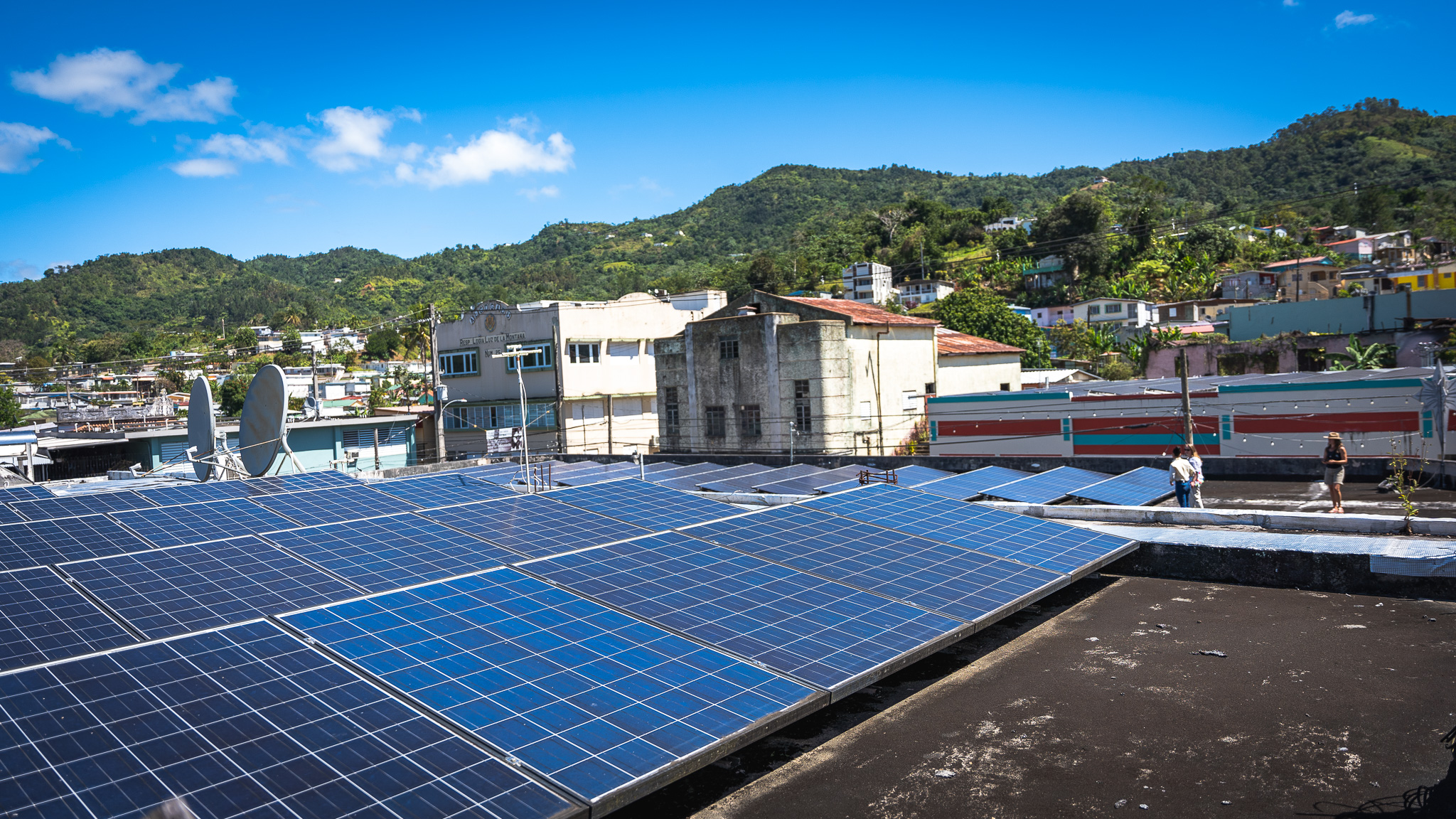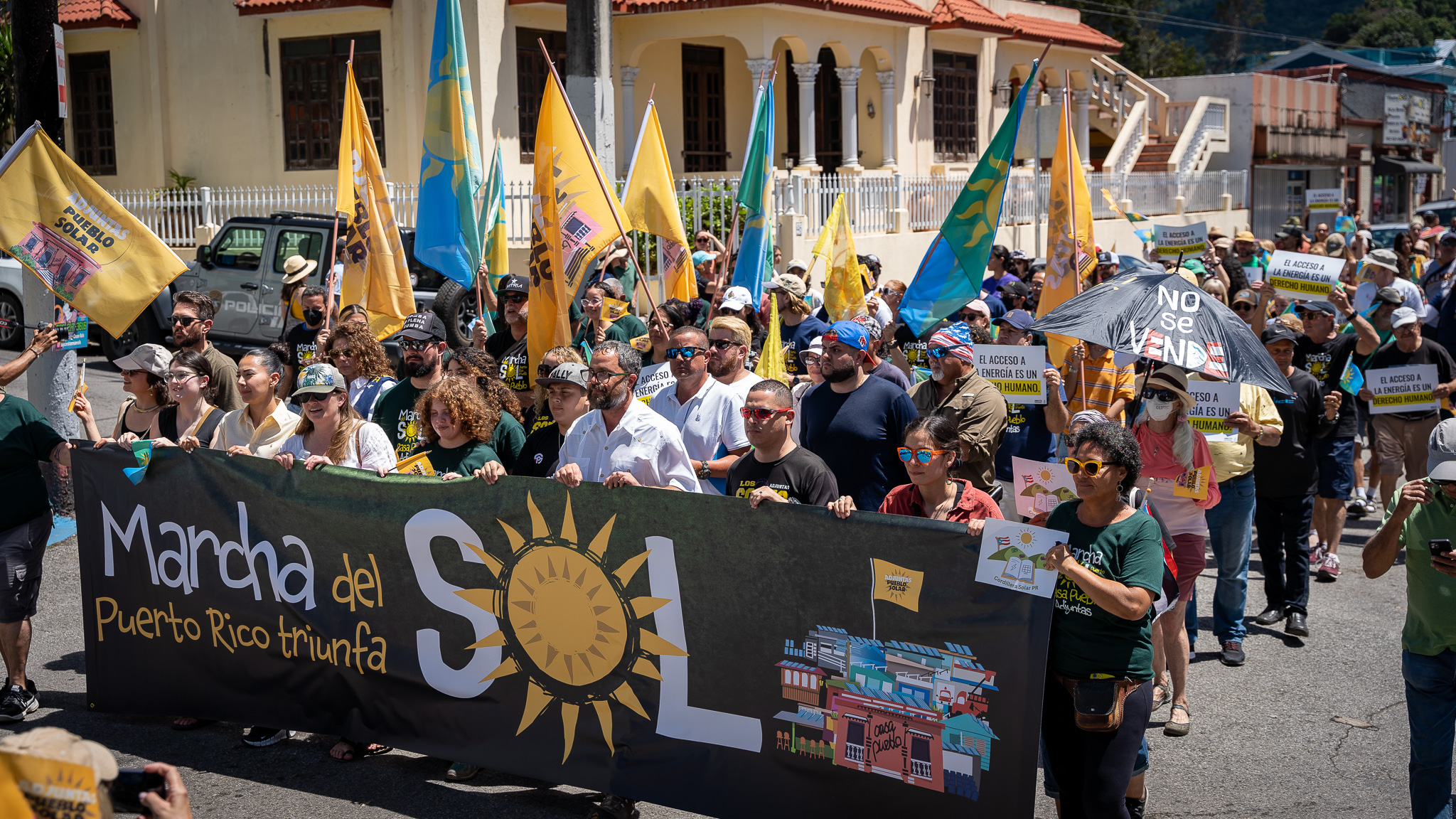
In Adjuntas, Puerto Rico, thousands of local residents bearing flags and placards marched through the small town over the weekend, accompanied by whistles and drums. It was a joyful display—some marchers walked on stilts; others twirled glossy streamers—all to celebrate a new cooperatively-owned solar microgrid, which had just been installed in the town center. After Hurricane Maria hit Puerto Rico in 2017, some residents of the town in the island’s mountainous central region were left without power for 11 months before Puerto Rico’s utility brought service back online. Now, thanks to the new project, 14 local businesses will be able to produce their own electricity and run for about 10 days using batteries connected to solar power installed on their roofs, even if connections to the main grid fail again.
Puerto Rico has an ancient, rickety power system, with residents dealing with frequent power outages even when the weather is good. Hurricanes bring the prospect of weeks or months without electricity. After Hurricane Fiona hit the island last fall, for instance, some towns were left without power for weeks. And the threat to the island is only growing, with such storms becoming more severe due to climate change.
In Adjuntas, at least, there’s a new layer of resilience. Businesses hooked up to the microgrid won’t have to rely on expensive, polluting diesel generators, previously the primary backup energy source, to keep their doors open if long term blackouts come again. The new system means they can also help provide essential services to people in the surrounding areas, storing medications like insulin in commercial freezers, and charging laptops and phones.
More from TIME
But for some of those involved in the project, those solar panels and batteries also have political implications. “We want to help decolonize Puerto Rico,” says Arturo Massol-Deya, executive director of Casa Pueblo de Adjuntas, the local organization that spearheaded the microgrid project. “It’s not just about solar panels for people to have power after a hurricane. It is much deeper and more important for the future of the island.”

Among Puerto Ricans, it’s not uncommon to view the island’s electrical distributor, U.S.-Canadian consortium LUMA, as a tool of colonial control. Residents in Puerto Rico pay more than double the U.S. average electricity rate for the least reliable electrical system in the country, with much of the power system being decades-old and in a state of disrepair. The majority of that power (97%) comes from centralized fossil fuel power plants, largely in the southern part of the island, which burn coal and natural gas imported from the U.S. mainland. Massol-Deya sees that all as part of a system of extractive colonialism that has helped keep people in small towns like Adjuntas poor, while transferring wealth to elites in San Juan and the U.S. mainland.
But cheap, locally-sourced renewable power, he says, could break that system, with businesses and residents paying lower rates for electricity, while profits are invested in maintenance and local community development, rather than benefiting power companies and fossil fuel producers. “Having the capacity to produce energy with local resources puts Puerto Rico in a better position to address the political future of the island,” Massol-Deya says. “We’re building energy freedom as a way to build means for self determination at the local scale.”
Read more: How Solar Power Helped Some Puerto Rico Homes Avoid Hurricane Fiona Blackouts
Agustín Carbó, the director of the U.S. Department of Energy’s Puerto Rico grid modernization and recovery team, has also become interested in the possibilities of community solar power. “We’ve discovered that there’s been a huge grassroots movement at the community level,” he says. Last month, the Energy Department announced that it was gathering feedback to implement a $1 billion fund to increase energy reliance and lower costs for Puerto Ricans; the department was particularly interested in rooftop solar projects and “community and critical service energy resilience,” which may include community microgrids like the one in Adjuntas.
Cynthia Arellano, a program manager at the Honnold Foundation (founded by professional rock climber Alex Honnold) which donated about $2 million to build the Adjuntas solar project, says that money could set off a sea change. “I think we are at the beginning of a wave of microgrid transformation,” she says. “In Puerto Rico, it makes a lot of sense.”
Carbó has high hopes as well. “In five years, we will have a completely different society, with more reliable energy and much more resilient in terms of the impacts of future hurricanes,” he says.
Still, some observers are skeptical. More than five years have passed since Hurricane Maria, and still billions of dollars in federal aid have yet to make a dent in the island’s power problems. And though Puerto Rico passed a law in 2019 mandating the island transition to 100% renewable energy by 2050, recent news has left the seriousness of that pledge in doubt: In January, the island handed control of its fleet of power plants to one of the island’s natural gas suppliers. Since the company can buy natural gas from itself, it will have an interest in continuing to burn fossil fuels.
Massol-Deya says he’s glad to see federal support for community solar energy in Puerto Rico—but he worries that the mainland’s money will become mired in the same red tape that left much of the Hurricane Maria recovery effort in limbo for years. He credits progress in places like Adjuntas to grassroots social movements: local people advocating for their local solutions against what he characterizes as a corrupt island government. “We need to galvanize these social movements to keep pushing for energy democracy,” he says. “Because it’s not going to happen from the top down.”
For now, that community solar push is still nascent. But other small towns are attempting to follow Adjuntas’s lead. “These rural communities are where a lot of the exciting renewable energy projects are happening because of their isolation and being neglected by the central government and hurricane response,” says Andrew Hermann, who directs the Monte Azul Foundation, a nonprofit working to bring a microgrid to the town of Maricao, in the western part of Puerto Rico. “This is why a lot of communities are coming together and deciding we need to do something different here.”
More Must-Reads from TIME
- Inside Elon Musk’s War on Washington
- Why Do More Young Adults Have Cancer?
- Colman Domingo Leads With Radical Love
- 11 New Books to Read in February
- How to Get Better at Doing Things Alone
- Cecily Strong on Goober the Clown
- Column: The Rise of America’s Broligarchy
- Introducing the 2025 Closers
Write to Alejandro de la Garza at alejandro.delagarza@time.com